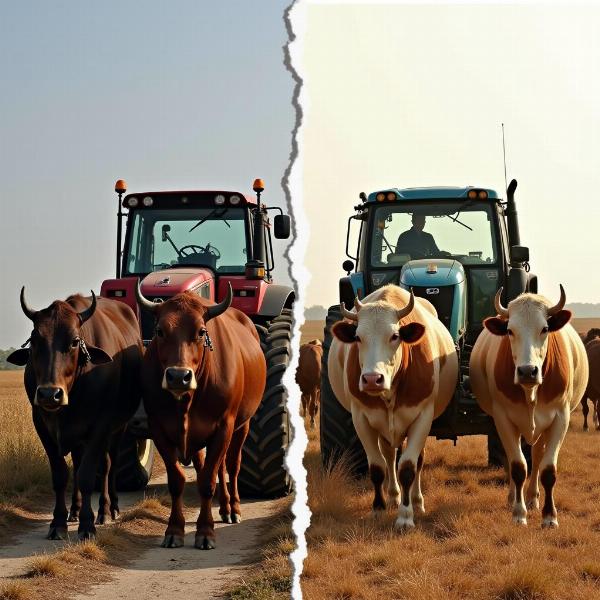Understanding the term “beast of burden” is crucial for anyone delving into Hindi literature, culture, or even everyday conversations. It refers to an animal, typically domesticated, used for carrying heavy loads or performing arduous tasks. This article will explore the meaning, cultural significance, and various translations of “beast of burden” in Hindi.
What Does “Beast of Burden” Mean in Hindi?
The most common Hindi translations for “beast of burden” are “भारवाही पशु” (bhaaravahi pashu) and “बोझा ढोने वाला जानवर” (bojha dhone wala jaanwar). Both phrases literally translate to “load-carrying animal.” While these are accurate translations, the cultural context adds layers of meaning that go beyond a simple definition.
Common Beasts of Burden in India
India has a long history of using animals for labor. Donkeys, oxen, camels, and even elephants have played vital roles in agriculture, transportation, and other industries. These animals are often seen as essential partners in rural livelihoods.
- Donkeys (गधा – gadha): Known for their resilience and ability to navigate difficult terrain, donkeys are frequently used for carrying goods in mountainous regions.
- Oxen (बैल – bail): A ubiquitous sight in rural India, oxen are integral to farming practices, pulling plows and carts.
- Camels (ऊँट – unt): Adapted to desert conditions, camels are vital for transportation and trade in arid regions of Rajasthan and Gujarat.
- Elephants (हाथी – hathi): While less common today, elephants historically played a significant role in logging and transportation, especially in forested areas.
Cultural Significance of Beasts of Burden
Beasts of burden are not merely working animals; they often hold cultural and even religious significance. In Hindu mythology, certain animals are revered and considered sacred. For instance, the cow (गाय – gaay) is highly respected and symbolizes motherhood and nurturing. While not typically a beast of burden, its importance in Indian society highlights the deep connection between humans and animals.
The Impact of Modernization
With modernization and technological advancements, the reliance on beasts of burden has decreased in urban areas. However, in rural India, these animals remain crucial for many communities. The changing landscape raises concerns about the welfare and future of these animals, prompting discussions about sustainable practices and alternative livelihoods.
 Modernization's Impact on Beasts of Burden
Modernization's Impact on Beasts of Burden
Why is Understanding “Beast of Burden” Important?
Understanding the term “beast of burden” is essential for appreciating the nuances of Hindi language and culture. It allows for a deeper understanding of historical contexts, social dynamics, and even religious beliefs. Whether reading classic literature, watching Bollywood films, or simply conversing with Hindi speakers, this knowledge enhances communication and fosters cultural sensitivity.
Are there other terms related to “Beast of Burden”?
Yes, terms like “pack animal” (पैक जानवर – paik jaanwar), “draft animal” (कर्षण पशु – karshan pashu) and “work animal” (काम करने वाला जानवर – kaam karne wala jaanwar) are also used, each with subtle differences in meaning. “Pack animal” specifically refers to animals used for carrying loads, while “draft animal” denotes animals used for pulling or hauling. “Work animal” is a broader term encompassing various types of animal labor.
Conclusion
“Beast of burden,” translated as “भारवाही पशु” (bhaaravahi pashu) or “बोझा ढोने वाला जानवर” (bojha dhone wala jaanwar) in Hindi, is more than just a linguistic term. It represents a deep-rooted connection between humans and animals, reflecting historical practices, cultural values, and the evolving landscape of rural India. Understanding this term provides valuable insights into the rich tapestry of Indian society.
FAQ
- What is the literal meaning of “beast of burden”? It refers to an animal used for carrying heavy loads or performing hard labor.
- What are some examples of beasts of burden in India? Donkeys, oxen, camels, and elephants are common examples.
- Why are beasts of burden important in Indian culture? They play a vital role in rural livelihoods and are often intertwined with cultural and religious beliefs.
- Is the use of beasts of burden declining in India? While declining in urban areas due to modernization, they remain essential in rural communities.
- What are some other terms related to “beast of burden”? Pack animal, draft animal, and work animal are related terms.
About Meaning-Hindi.in
Meaning-Hindi.in is your premier destination for professional Hindi translation services. We specialize in a wide range of translation solutions, including business and commercial documents, legal and certified translations, technical manuals, website localization, educational and academic materials, and expedited translation services. Our expert linguists ensure accurate and culturally sensitive translations for diverse industries. Contact us today for your translation needs!
Email: [email protected]
Phone: +91 11-4502-7584
Meaning-Hindi.in provides high-quality, reliable translations to bridge the communication gap between languages and cultures. With our expertise in various domains, we can help you achieve your communication goals effectively.